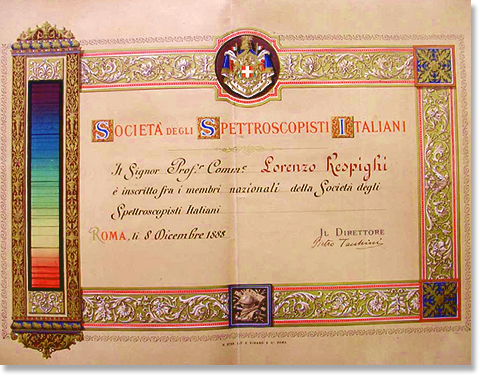
The Roma Observatory holds the heritage of the two main Observatories operating in Roma since the second half of the 18th century: the Observatory of Collegio Romano, under the charge of the Jesuit priests, and the Observatory of Campidoglio, conceded to the University of Roma in 1827. With the Unification of Italy, the former was doomed to be confiscated but, thanks to the scientific fame of its director, Angelo Secchi, there continued to be two Observatories in Roma, even though the Collegio Romano was later annexed to the Central Office for Meteorology. In 1923, the two Observatories definitively merged into the Royal Astronomical Observatory of Roma, which was at Campidoglio, where all the instruments were located. A few years later, in 1935, it was transferred to Monte Mario. In 1965, another site was opened in Monte Porzio Catone.
The Roma Observatory holds two historical archives: those belonging to the Observatory, and those of the Museum of Copernican Astronomy, an institution different in origin and scope from those of the Observatory. It will be necessary to conduct a careful and accurate selection, during the rearrangement operations, to distinguish documents of the two different producing bodies.
The Observatory archives contains the records tied to the vicissitudes of the institution. i.e. the activities of the Collegio Romano, Campidoglio, Monte Mario and Monte Porzio Catone Observatories.
Quite different is the second archives, or rather, the collection of the Museum of Copernican Astronomy, created in 1875 by the Polish nobleman Arturo Wolynski. He decided to open to the public his collections of Copernican astronomy antiquities, books and instruments, which eventually became the property of the Roma Observatory. In order to give rise to a proper astronomical museum, Wolynski requested items from the directors of the Italian observatories and from private citizens. He, thus, enlarged the collection with instruments, books, pamphlets, photographs, portraits, paintings and also manuscripts that came both from the original archives of the astronomical observatories and from the private collections of astronomers and their heirs. A major part of this material is made up of a collection of autographed documents.
The collection consists of about forty folders; the records are mainly letters from Italian and foreign scientists, scientific manuscripts, observations and calculations, log-books and also printed pamphlets.
The archives of the Museum of Copernican Astronomy include the materials relating to the formation and initial management of the Museum: letters by Wolynski, requests for donations, purchase proposals, and inventories of the acquired items.